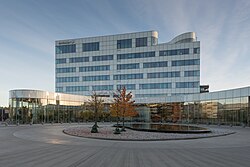Ericsson
 |
|

Ericsson's headquarters in Kista, .
|
|
| Publicly traded Aktiebolag | |
| Traded as |
Nasdaq Stockholm: ERIC-A Nasdaq Stockholm: ERIC-B NASDAQ: ERIC |
| Industry | Telecommunications equipment Networking equipment |
| Founded | Stockholm, Sweden (1876) |
| Founder | Lars Magnus Ericsson |
| Headquarters | Kista, Stockholm, Sweden |
|
Area served
|
Worldwide |
|
Key people
|
Leif Johansson (Chairman) Börje Ekholm ( President and CEO (Chief Executive Officer) ) |
| Products | Mobile and fixed broadband networks, consultancy and managed services, TV and multimedia technology |
| Revenue | SEK 222.6 billion (2016) |
| SEK 6.3 billion (2016) | |
| Profit | SEK 1.9 billion (2016) |
| Total assets | SEK 283.3 billion (2016) |
| Total equity | SEK 140.5 billion (2016) |
|
Number of employees
|
111,464 (Dec 31, 2016) |
| Subsidiaries | Ericsson Broadcast and Media Services |
| Website | www |
Ericsson (Telefonaktiebolaget L. M. Ericsson) is a multinational networking and telecommunications equipment and services company headquartered in , Sweden. The company offers services, software and infrastructure in information and communications technology (ICT) for telecommunications operators, traditional telecommunications and (IP) networking equipment, mobile and fixed broadband, operations and business support services, cable television, IPTV, video systems, and an extensive services operation. Ericsson had 35% market share in the 2G/3G/4G mobile network infrastructure market in 2012.
The company was founded in 1876 by Lars Magnus Ericsson; as of 2016[update] it is headquartered in , Sweden. The company employs around 113,000 people and operates in around 180 countries. Ericsson holds over 39,000 granted patents as of May 2015, including many in wireless communications.
Lars Magnus Ericsson began his association with telephones in his youth as an instrument maker. He worked for a firm that made telegraph equipment for the Swedish government agency Telegrafverket. In 1876, at the age of 30, he started a telegraph repair shop with help from his friend Carl Johan Andersson in central and repaired foreign-made telephones. In 1878 Ericsson began making and selling his own telephone equipment. His telephones were not technically innovative. In 1878 he made an agreement to supply telephones and switchboards to Sweden's first telecommunications operating company, Stockholms Allmänna Telefonaktiebolag.
Also in 1878, local telephone importer Numa Peterson hired Ericsson to adjust some telephones from the Bell Telephone Company. He bought a number of Siemens telephones and analyzed the technology; Ericsson had a scholarship at Siemens a few years earlier. He was familiar with Bell and Siemens Halske telephones through his firm's repair work for Telegrafverket and Swedish Railways. He improved these designs to produce a higher-quality instrument to be used by new telephone companies such as Rikstelefon to provide cheaper service than the Bell Group. Ericsson had no patent or royalty problems because Bell had not patented their inventions in Scandinavia. His training as an instrument maker was reflected in the standard of finish and the ornate design of Ericsson telephones of this period. At the end of the year he started to manufacture telephones much like those of Siemens; the first product was finished in 1879.
...
Wikipedia
